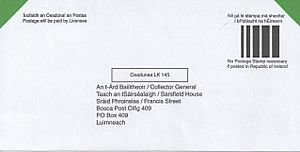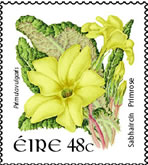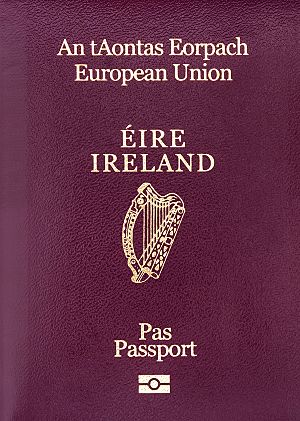Names of the Irish state facts for kids
Ireland is a country that takes up most of the island of Ireland. The rest of the island is Northern Ireland, which is part of the United Kingdom. Because of this, the country has different names to help people tell the difference between the country itself and the whole island.
According to its rulebook, the Constitution of Ireland, the official names of the country are Ireland (in English) and Éire (in Irish). From 1922 to 1937, it was known as the Irish Free State. In 1948, the country officially started using the term Republic of Ireland to describe itself, but this didn't change its main constitutional names. Other common names you might hear are the Republic, the 26 counties, or the South.
Contents
What are the Official Names?
The Constitution of Ireland, which was put in place in 1937, says that "The name of the State is Éire, or, in the English language, Ireland." This means Ireland has two official names: Éire in the Irish language and Ireland in English.
For official uses, the Irish government uses Éire in documents written in Irish. It uses Ireland for documents in English, including international agreements. The country's official positions and groups also use these names. For example, there is a President of Ireland and a Constitution of Ireland. The name Ireland is also used when the country works with other nations and in big international groups like the United Nations and the European Union.
The Irish language is given special importance in the Constitution. Because of this, Éire is the only name that appears on many national symbols. These include the President's Seal, postage stamps, and Irish euro coins.
The spelling "Eire" (without the little mark over the 'E') is not the correct way to spell it in Irish. However, the British government and media used this spelling for many years.
What is the Official Description?

Since 1949, a law called the Republic of Ireland Act 1948 has said that Republic of Ireland (or Poblacht na hÉireann in Irish) is the official description for the country. But Ireland is still the official name from the Constitution.
Usually, the constitutional name Ireland is used. However, the description Republic of Ireland is sometimes used when people want to make it clear they are talking about the country, not the whole island. People often shorten this to 'the Republic' when speaking casually.
This difference between a "description" and a "name" is important. The 1948 Act didn't change the country's name because that would have gone against the Constitution. The leader at the time, John A. Costello, explained it like this: "If I say that my name is Costello and that my description is that of senior counsel, I think that will be clear to anybody who wants to know... [Similarly, the state's] name in Irish is Éire and in the English language, Ireland. Its description in the English language is 'the Republic of Ireland.'"
Ireland and the European Union
Ireland joined the European Economic Community (now the European Union) in 1973. When it joined, the treaties were written in all the official EU languages, including English and Irish. So, Ireland joined under both its names, Éire and Ireland.
Since 2007, Irish has been an official working language of the EU. This didn't change the country's name in EU law. But it means that at official EU meetings, the nameplates for Ireland now show Éire – Ireland, instead of just Ireland.
The EU's style guide says that the official names are Éire and Ireland. It also says that the official name in English is Ireland. It specifically tells people: "NB: Do not use 'Republic of Ireland' nor 'Irish Republic'."
Names from History
Ancient Names
Long ago, the island of Ireland had many different names:
- Inis Ealga: This meant the noble or excellent island.
- Fiodh-Inis: This meant the Woody island.
- Crioch Fuinidh: This meant the Final or remote country.
- Inisfáil: This meant the Island of Destiny. From this, 'Fál' became an old name for Ireland. So, the Lia Fáil, or Stone of Destiny, meant 'Stone of Ireland'.
- Ériu, Banba, and Fódla: These names came from three queens of an ancient group called the Tuatha Dé Danann.
- Ierne: Ancient Greek writers used this name. Some scholars think it refers to Ireland even before 1000 BC.
- Ogygia: This meant the most ancient land. A writer named Plutarch used it in the first century, possibly for Ireland.
- Hibernia: Julius Caesar first used this name, and it became common for the Romans.
- Scotia: This meant the land of the Scots. Roman writers used it for Ireland. It referred only to Ireland until the 11th century when modern Scotland also started being called Scotia.
- Insula Sanctorum (Island of the Saints) and Insula Doctorum (Island of the Learned): These names led to the modern saying "Island of Saints and Scholars."
Before 1919
After the Normans invaded, Ireland was called the Lordship of Ireland (1171 to 1541). Then it became the Kingdom of Ireland (1541 to 1800). From 1801 to 1922, it was part of the United Kingdom of Great Britain and Ireland.
Irish Republic (1919–22)

In English, the revolutionary state declared in 1916 and confirmed in 1919 was called the Irish Republic. In Irish, two names were used: Poblacht na hÉireann and Saorstát Éireann. Poblacht means "republic," and Saorstát means "free state."
The Easter Proclamation of 1916 used Poblacht na hÉireann. But the Irish Declaration of Independence in 1919 used Saorstát Éireann.
Southern Ireland (1921–22)
Southern Ireland was an official name for a self-governing area of the United Kingdom from 1921 to 1922. It covered the same area as today's Irish state. However, due to political unrest and the Irish War of Independence, it never fully worked as planned. It was replaced by the Irish Free State in 1922. Today, Southern Ireland has no official status, but some older people in the UK still use it.
Irish Free State (1922–37)
During talks to become independent, Irish politicians wanted the country to be a republic called the Republic of Ireland. But the British government didn't agree because it meant breaking ties with the British Crown. Instead, they agreed the country would be a self-governing Dominion within the Commonwealth of Nations.
The name "Irish Free State" came from the Irish name Saorstát Éireann. This name wasn't very popular.
Éire (Irish language name since 1937)
As mentioned before, the Constitution of Ireland, from 1937, gave the country its two official names: Éire in Irish and Ireland in English. These names are direct translations of each other.
When the Constitution was being written, the leader, Éamon de Valera, first suggested only Éire as the name. Other politicians wanted Ireland to be used in the English text. De Valera agreed to add "or, in the English language, Ireland" to the Constitution.
After the Constitution was adopted, de Valera's government often encouraged using Éire, even in English. However, they also understood the importance of the name Ireland. For example, an Irish official in Berlin was told not to emphasize the Irish form of the name. He was advised that "it is the hope of everybody in this country that the use of 'Ireland' to describe the Twenty-Six Counties will have a definite psychological effect in favour of the unity of this country on both Irish and foreign minds."

The use of Éire in English was sometimes criticized as confusing. Some worried it might make people think Éire only referred to the 26 counties, not the whole island. Despite these concerns, Éire (often spelled Eire in English) became widely accepted. However, after the Republic of Ireland Act was passed in 1949, the name Éire became less common in English, though it still appears on stamps.
Abbreviations
For international codes, Ireland has a two-letter code "IE" and a three-letter code "IRL". The "IE" code is used for Irish internet addresses. The IRL code appears on Irish driving licenses and passports. It is also seen on Irish vehicle registration plates.
Other Names Used
People use various other names for the Irish state. Sometimes these names are chosen to avoid confusion with the island of Ireland. Other times, they are used for political reasons.
Republic of Ireland, which is the official "description" of the country, is often used. In sports, the national football team plays as the "Republic of Ireland." This is because two different football organizations used to have teams called "Ireland." To avoid confusion, FIFA decided that the teams should be called "Republic of Ireland" and "Northern Ireland."
Irish Republic is a name often used in Britain for the country. However, in Ireland, "Irish Republic" usually refers to the revolutionary state that existed from 1919. The short form "ROI" (for Republic of Ireland) is also common. Shorter, informal names include "the Republic" or "the South."
Some Irish republicans and those who oppose the division of Ireland often call the country the "Twenty-Six Counties" or "26 Counties." They call Northern Ireland the "Six Counties." They sometimes also use "Free State," referring to the country before 1937. They use these names to show that they believe Ireland should be one united island.
Telling the Country Apart from the Island
When the name "Ireland" could be unclear (meaning either the country or the island), the Irish government now uses "island of Ireland" for the island and "the state" for the country.
Name Dispute with the UK
There used to be a long disagreement between the Irish and British governments about their official names. Ireland wanted to be called "Ireland," and the UK wanted to call it "Eire" or "Republic of Ireland."
The "Eire" vs. "Ireland" Debate
In 1937, when Ireland adopted its new Constitution, it claimed the "whole island of Ireland." This was seen by the British as a claim to Northern Ireland. The Constitution also said the name was "Éire, or, in the English language, Ireland."
The British government decided to use "Eire" (without the accent) when referring to the Irish state. They wanted to avoid using "Ireland" because they felt it implied a claim to the whole island. A British law in 1938 even stated that the former "Irish Free State shall be styled as ... Eire" for UK legal purposes.
Even though the Irish government, led by Éamon de Valera, sometimes encouraged using "Éire" in English, they also insisted on "Ireland" in international settings. For example, at the League of Nations, they said "Ireland" was the correct English name.
"Republic of Ireland" vs. "Ireland"
In 1949, Ireland passed the Republic of Ireland Act, which declared that the "description of the State shall be the Republic of Ireland."
The British government then passed the Ireland Act 1949. This law formally allowed the name Republic of Ireland to be used in British law instead of Eire. Later, the name Eire was completely removed from British law in 1981. So, Republic of Ireland became the only name for the Irish state officially recognized in UK law.
However, the Irish government still insisted that the name of the country was Ireland, and "Republic of Ireland" was just a description. When Ireland joined the United Nations in 1955 and the European Economic Community in 1973, it did so as Ireland, despite protests from the United Kingdom.
The Irish government also objected to the UK calling itself the "United Kingdom of Great Britain and Northern Ireland." They didn't like the "and Northern Ireland" part because it went against their claim to Northern Ireland. This disagreement was clear in treaties between the two countries. For example, in the Anglo-Irish Agreement of 1985, the British text called the Irish side the "Government of the Republic of Ireland," while the Irish text called itself the "Government of Ireland."
The Good Friday Agreement
The disagreement over names was largely settled with the Good Friday Agreement (also called the Belfast Agreement) in 1998. As part of this agreement, Ireland dropped its legal claim to Northern Ireland.
In the agreement's title, both governments used their preferred names. The UK used "Government of the United Kingdom of Great Britain and Northern Ireland," and Ireland used "Government of Ireland." This meant that each government agreed to use the name the other preferred.
A British minister, Lord Dubs, explained that this change showed a "welcome disappearance of one small but significant difference in practice." He said, "We will call them by the name they favour, and they will use the name for us that we favour."
Since the Good Friday Agreement, both governments have generally respected this policy. Even though the UK's Ireland Act 1949 still allows "Republic of Ireland" to be used, many new UK laws and regulations now simply refer to the Irish state as Ireland. For example, the Loans to Ireland Act 2010 calls the country "Ireland."
However, some British media still use different terms:
- The Times: Uses "Republic of Ireland" or "Irish Republic."
- The Guardian: Uses "Ireland, Irish Republic."
- The Economist: Says "Ireland is simply Ireland. Although it is a republic, it is not the Republic of Ireland."
- BBC News style guide: Suggests using "Republic of Ireland" or "the Irish Republic" at first, then "Ireland" or "the Republic."
See also


